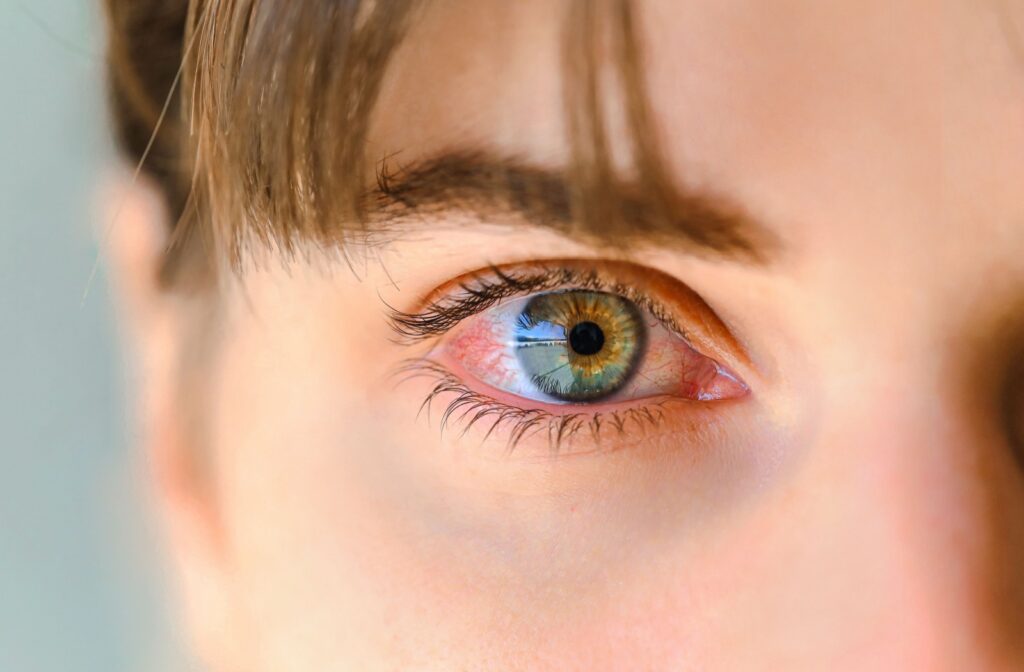If you’ve ever dealt with pink eye, you know how frustrating this eye condition can be. Redness, irritation, watery eyes—it can be extremely uncomfortable to deal with. Fortunately, your optometrist can help you find relief, but what exactly causes pink eye? Can you get it from a sinus infection?
Pink eye can be caused by several different factors, and sinus infections are included in this list. Your sinuses run along behind your eyes, and when they become infected or inflamed, it can lead to bacteria spreading into the eye.
What Is Pink Eye?
The whites of your eyes and the inside of your eyelids are covered with a thin, clear tissue called the conjunctiva. It helps to keep your eyes protected from irritants like dust and germs. However, it’s also extremely sensitive, and sometimes, it can become easily inflamed. When you start to notice irritation and visible redness in the eyes, it’s likely conjunctivitis—better known as pink eye.
There are 3 types of pink eye, each with its own symptoms and causes:
- Bacterial pink eye
- Viral pink eye
- Allergic pink eye
Bacterial Pink Eye
Bacterial pink eye is caused by a bacterial infection inflaming the area around the eye. It often causes a thick yellow-green discharge around the eyes, along with:
- Redness in the white of the eye or inner eyelid
- Increased tear production
- A gritty feeling in the eye
- Itching or burning sensations
- Sensitivity to light
Typically, this can be treated with antibiotics. These can be administered as an ointment or an eye drop, and aim to control the infection. Bacterial pink eye is extremely contagious, so you need to make sure to practice proper hygiene while you’re exhibiting symptoms; this way, you can lower the risk of transmitting the condition to others.
Viral Pink Eye
Viral pink eye is caused by a virus, like the common cold or flu. It’s the most common type of conjunctivitis and is extremely contagious—even just exposure to a contaminated surface can spread the condition.
Typically, viral pink eye causes:
- Watery, itchy eyes
- Sensitivity to light
- A feeling of grittiness in the eyes
- Swelling of the eyelids
Unlike bacterial pink eye, viral conjunctivitis doesn’t respond to antibiotics. Instead, treatment aims to give you relief from your symptoms while the virus runs its course. While you’re waiting for symptoms to recede, you need to maintain good hygiene to prevent the spread of the virus.
Allergic Pink Eye
Allergic pink eye is a reaction to allergens like pollen or dust. This type isn’t contagious; it’s just your body reacting to a contaminant. It often appears alongside other allergy symptoms, like constant sneezing or coughing.
This condition can cause;
- Itchy, watery eyes
- Redness and irritation in both eyes
- Swollen eyelids
- Sensitivity to light
With allergic pink eye, you can find relief with over-the-counter antihistamines or anti-inflammatory eye drops. Your optometrist can also give you advice on preventing this condition, like avoiding allergens, using an air purifier, or even considering allergy shots.
What Is Sinusitis?
Inside your skull, you have several small air-filed cavities. They’re located behind your cheekbones, nose, and forehead, and help your nasal passages trap dust and other particles.
These are your sinuses. When they become inflamed, swollen, or irritated due to bacteria or viruses, it’s called “sinusitis.” This condition can cause:
- Thick, discolored nasal discharge
- Nasal stuffiness
- Facial pain or pressure
- Headaches
It’s a lot more common than most people think; it’s believed that it can affect roughly 30 million Americans every year. While it’s highly treatable, it can also be extremely irritating—and cause further symptoms and problems in the surrounding area.
Can Sinus Infections Spread to the Eye?
The sinuses run extremely close to the eyes—and your eyes are extremely sensitive. When bacteria or viruses settle in the sinuses, they can easily migrate to the surrounding area. This risk increases significantly if you subconsciously rub the area; your hands can spread the bacteria or virus to the eye itself.
Then, you’ll likely start to deal with the symptoms of pink eye. The redness, irritation, and discharge may appear in one or both eyes, and it can be just as contagious as any other type of pink eye. If you’re experiencing symptoms of a sinus infection alongside those of conjunctivitis, you should visit your optometrist as soon as you can to discuss treatment.

How to Treat Pink Eye
There is good news—if you’re dealing with pink eye, your optometrist can likely help. The treatment depends on the type of pink eye you’re experiencing.
For bacterial pink eye, antibiotics are usually the solution. Make sure you finish the entire course to eradicate all bacteria; otherwise, it could reoccur. For allergic pink eye, you can usually find relief through antihistamines, allergy medication, and over-the-counter eye drops. For viral pink eye, you’ll need to wait for your body to fight off the virus. In all cases, good hygiene and avoiding touching your eyes are essential to prevent spreading the condition.
Visit Your Optometrist
If you’re dealing with pink eye, or any other eye condition, reachout to our team at Dr. Goldstone Vision Center. Our team can give you a proper diagnosis and help you find relief from your symptoms. There’s no need to suffer in silence; book an appointment with our team today!



